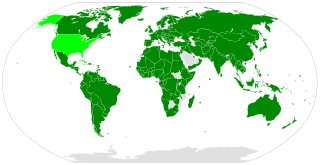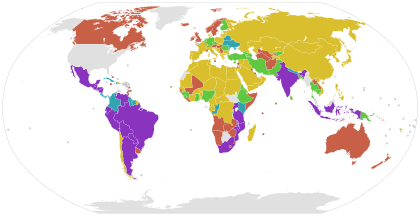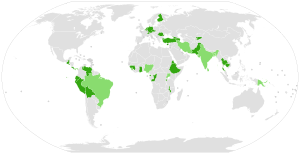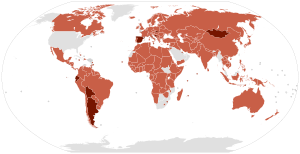
The International Covenant on Civil and Political Rights (ICCPR) is a multilateral treaty that commits nations to respect the civil and political rights of individuals, including the right to life, freedom of religion, freedom of speech, freedom of assembly, electoral rights and rights to due process and a fair trial. It was adopted by United Nations General Assembly Resolution 2200A (XXI) on 16 December 1966 and entered into force on 23 March 1976 after its thirty-fifth ratification or accession. As of June 2022, the Covenant has 173 parties and six more signatories without ratification, most notably the People's Republic of China and Cuba; North Korea is the only state that has tried to withdraw.

The International Covenant on Economic, Social and Cultural Rights (ICESCR) is a multilateral treaty adopted by the United Nations General Assembly (GA) on 16 December 1966 through GA. Resolution 2200A (XXI), and came into force on 3 January 1976. It commits its parties to work toward the granting of economic, social, and cultural rights (ESCR) to all individuals including those living in Non-Self-Governing and Trust Territories. The rights include labour rights, the right to health, the right to education, and the right to an adequate standard of living. As of July 2020, the Covenant has 171 parties. A further four countries, including the United States, have signed but not ratified the Covenant.
Economic, social and cultural rights (ESCR) are socio-economic human rights, such as the right to education, right to housing, right to an adequate standard of living, right to health, victims' rights and the right to science and culture. Economic, social and cultural rights are recognised and protected in international and regional human rights instruments. Member states have a legal obligation to respect, protect and fulfil economic, social and cultural rights and are expected to take "progressive action" towards their fulfilment.

The International Bill of Human Rights was the name given to UN General Assembly Resolution 217 (III) and two international treaties established by the United Nations. It consists of the Universal Declaration of Human Rights, the International Covenant on Civil and Political Rights with its two Optional Protocols and the International Covenant on Economic, Social and Cultural Rights. The two covenants entered into force in 1976, after a sufficient number of countries had ratified them.

The human right to water and sanitation (HRWS) is a principle stating that clean drinking water and sanitation are a universal human right because of their high importance in sustaining every person's life. It was recognized as a human right by the United Nations General Assembly on 28 July 2010. The HRWS has been recognized in international law through human rights treaties, declarations and other standards. Some commentators have based an argument for the existence of a universal human right to water on grounds independent of the 2010 General Assembly resolution, such as Article 11.1 of the International Covenant on Economic, Social and Cultural Rights (ICESCR); among those commentators, those who accept the existence of international ius cogens and consider it to include the Covenant's provisions hold that such a right is a universally binding principle of international law. Other treaties that explicitly recognize the HRWS include the 1979 Convention on the Elimination of All Forms of Discrimination Against Women (CEDAW) and the 1989 Convention on the Rights of the Child (CRC).

The Convention on the Rights of Persons with Disabilities is an international human rights treaty of the United Nations intended to protect the rights and dignity of persons with disabilities. Parties to the convention are required to promote, protect, and ensure the full enjoyment of human rights by persons with disabilities and ensure that persons with disabilities enjoy full equality under the law. The Convention serves as a major catalyst in the global disability rights movement enabling a shift from viewing persons with disabilities as objects of charity, medical treatment and social protection towards viewing them as full and equal members of society, with human rights. The convention was the first U.N. human rights treaty of the twenty-first century.

The Optional Protocol to the International Covenant on Economic, Social and Cultural Rights is an international treaty establishing complaint and inquiry mechanisms for the International Covenant on Economic, Social and Cultural Rights. It was adopted by the UN General Assembly on 10 December 2008, and opened for signature on 24 September 2009. As of October 2023, the Protocol has 46 signatories and 28 state parties. It entered into force on 5 May 2013.

The First Optional Protocol to the International Covenant on Civil and Political Rights is an international treaty establishing an individual complaint mechanism for the International Covenant on Civil and Political Rights (ICCPR). It was adopted by the UN General Assembly on 16 December 1966, and entered into force on 23 March 1976. As of January 2023, it had 117 state parties and 35 signatories. Two of the ratifying states have denounced the protocol.

The right to housing is the economic, social and cultural rightto adequate housing and shelter. It is recognized in some national constitutions and in the Universal Declaration of Human Rights and International Covenant on Economic, Social and Cultural Rights. The right to housing is regarded as a freestanding right in the International human rights law which was clearly in the 1991 General Comment on Adequate Housing by the UN Committee on Economic, Social and Cultural Rights. The aspect of the right to housing under ICESCR include: availability of services, infrastructure, material and facilities; legal security of tenure; habitability; accessibility; affordability; location and cultural adequacy.
The right to social security is recognized as a human right and establishes the right to social security assistance for those unable to work due to sickness, disability, maternity, employment injury, unemployment or old age. Social security systems provided for by states consist of social insurance programs, which provide earned benefits for workers and their families by employment contributions, and/or social assistance programs which provide non-contributory benefits designed to provide minimum levels of social security to persons unable to access social insurance.
Papua New Guinea (PNG) is a constitutional parliamentary democracy with an estimated population of 6,187,591. Police brutality, provincial power struggles, violence against women, and government corruption all contribute to the low awareness of basic human rights in the country.
Human rights and climate change is a conceptual and legal framework under which international human rights and their relationship to global warming are studied, analyzed, and addressed. The framework has been employed by governments, United Nations organizations, intergovernmental and non-governmental organizations, human rights and environmental advocates, and academics to guide national and international policy on climate change under the United Nations Framework Convention on Climate Change (UNFCCC) and the core international human rights instruments. In 2022 Working Group II of the IPCC suggested that "climate justice comprises justice that links development and human rights to achieve a rights-based approach to addressing climate change".
The right to adequate clothing, or the right to clothing, is recognized as a human right in various international human rights instruments; this, together with the right to food and the right to housing, are parts of the right to an adequate standard of living as recognized under Article 11 of the International Covenant on Economic, Social and Cultural Rights (ICESCR). The right to clothing is similarly recognized under Article 25 of the Universal Declaration of Human Rights (UDHR).
The Voluntary Guidelines to support the Progressive Realization of the Right to Adequate Food in the Context of National Food Security, also known as the Right to Food Guidelines, is a document adopted by the Food and Agriculture Organization of the United Nations in 2004, with the aim of guiding states to implement the right to food. It is not legally binding, but directed to states' obligations to the right to food under international law. In specific, it is directed towards States Parties to the International Covenant on Economic, Social and Cultural Rights (ICESCR) and to States that still have to ratify it.
The 1997 Maastricht Guidelines on Violations of Economic, Social and Cultural Rights build on the 1987 Limburg Principles on the Implementation of the International Covenant on Economic, Social and Cultural Rights and identify the legal implications of acts and omissions which are violations of economic, social and cultural rights. The guidelines were adopted by a group of over thirty experts who convened from 22–26 January 1997 in Maastricht on the occasion of the Limburg Principles' 10th anniversary. Three years later, the Maastricht Guidelines along with the Limburg Principles were reissued as UN document E/C.12/2000/13 by the Committee on Economic, Social and Cultural Rights (CESCR).
The Universal Declaration on the Eradication of Hunger and Malnutrition was adopted on 16 November 1974, by governments who attended the 1974 World Food Conference that was convened under General Assembly resolution 3180 (XXVIII) of 17 December 1973. It was later endorsed by General Assembly resolution 3348 (XXIX), of 17 December 1974. This Declaration combined discussions of the international human right to adequate food and nutrition with an acknowledgement of the various economic and political issues that can affect the production and distribution of food related products. Within this Declaration, it is recognised that it is the common purpose of all nations to work together towards eliminating hunger and malnutrition. Further, the Declaration explains how the welfare of much of the world's population depends on their ability to adequately produce and distribute food. In doing so, it emphasises the need for the international community to develop a more adequate system to ensure that the right to food for all persons is recognised. The opening paragraph of the Declaration, which remains to be the most recited paragraph of the Declaration today, reads:
Every man, woman and child has the inalienable right to be free from hunger and malnutrition in order to develop fully and maintain their physical and mental faculties.
This section provides an overview of the status of the right to food at a national level.

Development is a human right that belongs to everyone, individually and collectively. Everyone is “entitled to participate in, contribute to, and enjoy economic, social, cultural and political development, in which all human rights and fundamental freedoms can be fully realized,” states the groundbreaking UN Declaration on the Right to Development, proclaimed in 1986.
As prescribed in the Constitution of Tokelau, individual human rights are those found in the Universal Declaration of Human Rights and reflected in the International Covenant on Civil and Political Rights. When exercising these rights, there must be proper recognition of the rights of others and to the community as a whole. If an individual believes their rights have been breached they may go to the Council for the Ongoing Government who may make any appropriate order to protect that individual’s rights. There have been no such complaints to date.
The International Food Security Treaty (IFST) is a proposed covenant between nations aiming to place the human right of freedom from hunger under the protection of enforceable national and international laws.















